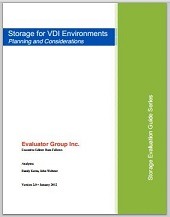Storage for VDI Environments: Planning and Considerations

Virtual Desktop Infrastructure (also known as VDI) is a growing trend among companies in an effort to reduce costs and administrative overhead while improving reliability and security of users desktops. The three primary vendors with desktop virtualization software are Citrix, Microsoft and VMware. Successful implementations require several factors, including reasonable costs and good performance from desktop users’ perspective.
Bringing the desktop applications, operating systems, and storage into a centralized IT function represents opportunities to save in administrative costs, system costs, and enhance the security of business data.
Achieving performance for virtual desktops while maintaining costs at levels similar to traditional desktops requires careful planning and architecture, and an understanding of how to optimize the most common bottleneck encountered.
Storage is often cited as the item most often responsible for performance success or failures, and also has the largest impact on total costs. Achieving good cost – performance levels requires a storage architecture optimized for VDI. The issues relating to storage can be categorized into three areas: storage capacity, storage performance requirements, and administrative changes.
This paper examines the issues IT architects and administrators should consider before embarking on a VDI implementation. Download this white paper to read more.
Oops! We could not locate your form.

